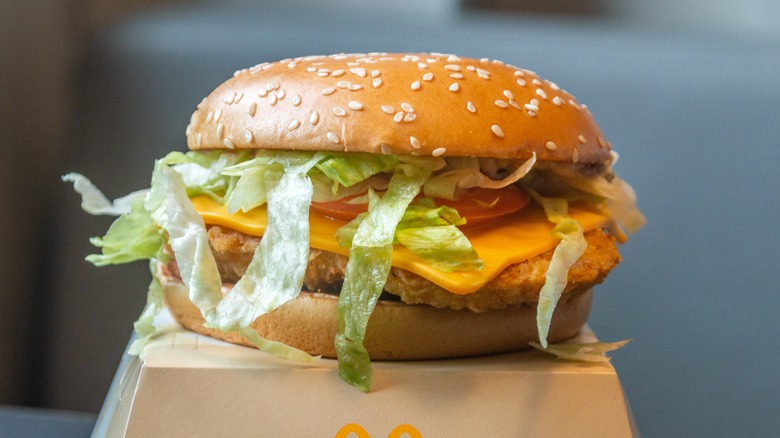McDonald's McChicken Is 200% More Expensive Than It Was 10 Years Ago
Anyone who has been grocery shopping in the past several years knows inflation is a problem. Though food inflation eased by leaps and bounds in 2023, that doesn't mean prices went back down; it just means they aren't getting worse as fast as they were. When it comes to fast food prices, this rise in costs has led a lot of people to wonder if dollar fast food menus even still exist. Of all major fast food chains, McDonald's was once known for its especially low prices,but even it has increased its prices by a lot over the years.
The McChicken was once one of the crown jewels of McDonald's dollar menu, but the days of a $1 McChicken are now far behind us. According to a statistical analysis from FinanceBuzz, McDonald's prices are up across the board. The Big Mac price has increased 50% between 2014 and 2024, but that is one of the menu items that has increased the least. Nowhere is inflation more visible than with the McChicken, which cost about $1.19 in 2014 but rose 168% to the price of $3.19 as of 2024. Plus, there are plenty of anecdotal online reports of the price being even higher, with some claiming McChickens in their area can cost upwards of $5.
McDonald's says its prices haven't increased that much
McDonald's isn't alone here. Over the last decade, many major fast food chains have experienced tremendous rises in inflation. While McDonald's led the way with a 100% price increase across its menu in the past decade, Popeye's, Taco Bell, and Chipotle aren't far behind, increasing their prices between 75% and 86% across the same time period. Meanwhile, Jimmy John's, Arby's, Burger King, Chick-fil-A, Panera, and Wendy's register a bit behind them. The lowest increases, meanwhile, belong to Starbucks and Subway, which are both around 39%.
It's worth noting that McDonald's disputes the accuracy of this data, with a spokesperson for the company telling Delish, "This is not an accurate representation of pricing at McDonald's restaurants." Nevertheless, the fast food juggernaut does seems to recognize there's an issue, as McDonald's has considered a potential new value meal that could mean cheaper fast food.
FinanceBuzz does admit there is some variance in its data as well, saying "McDonald's franchisees are given a high level of autonomy in setting menu prices for individual locations, which can make it difficult to accurately source historical data to compare to the present." However, the site also insists that it collected as many additional data points as possible to minimize this problem.
McDonald's often makes a good barometer for inflation
There are good reasons to consider McDonald's food as a general barometer for inflation, as long as you acknowledge it doesn't follow along at precisely a 100% rate. The Big Mac Index was originally designed — and is primarily still used — to show differences in exchange rates between countries, as the Big Mac is a popular and widely available good in dozens of nations with a price control owing to only one company selling it.
It's also useful (though imperfect) for domestic prices, as these qualities tend to make it run in the same general direction as inflation. Some economic experts actually believe the Big Mac Index is a more accurate measure of inflation than people realize, and that the Consumer Price Index actually underreports the total amount. This principle doesn't just apply to the Big Mac, as the McChicken illustrates a lot of the same principles (albeit more dramatically than any other menu item).
Whether McChickens are up by 168% or something more like 50%, it seems difficult to dispute that its price is on the rise. This trend makes for a less than ideal situation for fast food sandwich lovers everywhere.


